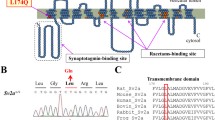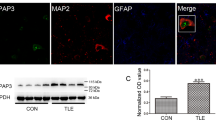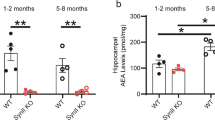Summary
Synaptic vesicle protein 2A (SV2A) involvement has been reported in the animal models of epilepsy and in human intractable epilepsy. The difference between pharmacosensitive epilepsy and pharmacoresistant epilepsy remains poorly understood. The present study aimed to observe the hippocampus SV2A protein expression in amygdale-kindling pharmacoresistant epileptic rats. The pharmacosensitive epileptic rats served as control. Amygdaloid-kindling model of epilepsy was established in 100 healthy adult male Sprague-Dawley rats. The kindled rat model of epilepsy was used to select pharmacoresistance by testing their seizure response to phenytoin and phenobarbital. The selected pharmacoresistant rats were assigned to a pharmacoresistant epileptic group (PRE group). Another 12 pharmacosensitive epileptic rats (PSE group) served as control. Immunohistochemistry, real-time PCR and Western blotting were used to determine SV2A expression in the hippocampus tissue samples from both the PRE and the PSE rats. Immunohistochemistry staining showed that SV2A was mainly accumulated in the cytoplasm of the neurons, as well as along their dendrites throughout all subfields of the hippocampus. Immunoreactive staining level of SV2A-positive cells was 0.483±0.304 in the PRE group and 0.866±0.090 in the PSE group (P<0.05). Real-time PCR analysis demonstrated that 2-ΔΔCt value of SV2A mRNA was 0.30±0.43 in the PRE group and 0.76±0.18 in the PSE group (P<0.05). Western blotting analysis obtained the similar findings (0.27±0.21 versus 1.12±0.21, P<0.05). PRE rats displayed a significant decrease of SV2A in the brain. SV2A may be associated with the pathogenesis of intractable epilepsy of the amygdaloid-kindling rats.
Similar content being viewed by others
References
Sander JW. The epidemiology of epilepsy revisited. Curr Opin Neurol, 2003,16(2):165–170
Schuele SU, Luders HO. Intractable epilepsy: management and therapeutic alternatives. Lancet Neurol, 2008,7 (6):514–524
Noyer M, Gillard M, Matagne A, et al. The novel antiepileptic drug levetiracetam (ucb L059) appears to act via a specific binding site in CNS membranes. Eur J Pharmacol, 1995,286(2):137–146
Crowder KM, Gunther JM, Jones TA, et al. Abnormal neurotransmission in mice lacking synaptic vesicle protein 2A (SV2A). Proc Natl Acad Sci U S A, 1999,96(26): 15268–15273
Janz R, Goda Y, Geppert M, et al. SV2A and SV2B function as redundant Ca2+ regulators in neurotransmitter release. Neuron, 1999,24(4):1003–1016
van Vliet EA, Aronica E, Redeker S, et al. Decreased expression of synaptic vesicle protein 2A, the binding site for levetiracetam, during epileptogenesis and chronic epilepsy. Epilepsia, 2009,50(3):422–433
Feng G, Xiao F, Lu Y, et al. Down-regulation synaptic vesicle protein 2A in the anterior temporal neocortex of patients with intractable epilepsy. J Mol Neurosci, 2009,39(3):354–359
Glauser TA, Ayala R, Elterman RD, et al. Double-blind placebo-controlled trial of adjunctive levetiracetam in pediatric partial seizures. Neurology, 2006,66(11):1654–1660
Mohanraj R, Parker PG, Stephen LJ, et al. Levetiracetam in refractory epilepsy: a prospective observational study. Seizure, 2005,14(1):23–27
French J, Edrich P, Cramer JA. A systematic review of the safety profile of levetiracetam: a new antiepileptic drug. Epilepsy Res, 2001,47(12):77–90
Grosso S, Cordelli DM, Franzoni E, et al. Efficacy and safety of levetiracetam in infants and young children with refractory epilepsy. Seizure, 2007,16(4):345–350
Opp J, Tuxhorn I, May T, et al. Levetiracetam in children with refractory epilepsy: a multicenter open label study in Germany. Seizure, 2005,14(7):476–484
Lynch BA, Lambeng N, Nocka K, et al. The synaptic vesicle protein SV2A is the binding site for the antiepileptic drug levetiracetam. Proc Natl Acad Sci USA, 2004,101 (26):9861–9866
Gillard M, Chatelain P, Fuks B. Binding characteristics of levetiracetam to synaptic vesicle protein 2A (SV2A) in human brain and in CHO cells expressing the human recombinant protein. Eur J Pharmacol, 2006,536(1–2):102–108
Schulze-Bonhage A. Brivaracetam for the treatment of epilepsy. Expert Opin Pharmacother, 2011,12(12):1959–1966
Bennett B, Matagne A, Michel P, et al. Seletracetam (UCB 44212). Neurotherapeutics, 2007,4(1):117–122
von Rosenstiel P. Brivaracetam (UCB 34714). Neurotherapeutics, 2007,4(1):84–87
Bajjalieh SM, Frantz GD, Weimann JM, et al. Differential expression of synaptic vesicle protein 2 (SV2) isoforms. J Neurosci, 1994,14(9):5223–5235
Janz R, Sudhof TC. SV2C is a synaptic vesicle protein with an unusually restricted localization: anatomy of a synaptic vesicle protein family. Neuroscience, 1999,94(4): 1279–1290
Toering ST, Boer K, de Groot M, et al. Expression patterns of synaptic vesicle protein 2A in focal cortical dysplasia and TSC-cortical tubers. Epilepsia, 2009,50(6): 1409–1418
Wu G, Hong Z, Li Y, et al. Effects of low-frequency hippocampal stimulation on gamma-amino butyric acid type B receptor expression in pharmacoresistant amygdaloid kindling epileptic rats. Neuromodulation, 2012,16(2):105–113
Freeman FG, Jarvis MF. The effect of interstimulation interval on the assessment and stability of kindled seizure thresholds. Brain Res Bull, 1981,7(6):629–633
Lopez-Meraz ML, Neri-Bazan L, Rocha L. Low frequency stimulation modifies receptor binding in rat brain. Epilepsy Res, 2004,59(2–3):95–105
Racine R, Okujava V, Chipashvili S. Modification of seizure activity by electrical stimulation. 3. Mechanisms. Electroencephalogr Clin Neurophysiol, 1972,32(3):295–299
Zhang Q, Wu ZC, Yu JT, et al. Mode-dependent effect of high-frequency electrical stimulation of the anterior thalamic nucleus on amygdala-kindled seizures in rats. Neuroscience, 2012,217:113–122
Loscher W, Reissmuller E, Ebert U. Anticonvulsant efficacy of gabapentin and levetiracetam in phenytoinresistant kindled rats. Epilepsy Res, 2000,40(1):63–77
Brandt C, Bethmann K, Gastens AM, et al. The multidrug transporter hypothesis of drug resistance in epilepsy: Proof-of-principle in a rat model of temporal lobe epilepsy. Neurobiol Dis, 2006,24(1):202–211
Buckley K, Kelly RB. Identification of a transmembrane glycoprotein specific for secretory vesicles of neural and endocrine cells. J Cell Biol, 1985,100(4):1284–1294
Xu T, Bajjalieh SM. SV2 modulates the size of the readily releasable pool of secretory vesicles. Nat Cell Biol, 2001,3(8):691–698
Meehan AL, Yang X, Mc Adams BD, et al. A new mechanism for antiepileptic drug action: vesicular entry may mediate the effects of levetiracetam. J Neurophysiol, 2011,106(3):1227–1239
Kaminski RM, Matagne A, Leclercq K, et al. SV2A protein is a broad-spectrum anticonvulsant target: functional correlation between protein binding and seizure protection in models of both partial and generalized epilepsy. Neuropharmacology, 2008,54(4):715–720
van Vliet EA, van Schaik R, Edelbroek PM, et al. Development of tolerance to levetiracetam in rats with chronic epilepsy. Epilepsia, 2008,49(7):1151–1159
Sills GJ. SV2A in epilepsy: the plot thickens. Epilepsy Curr, 2010,10(2):47–49
Gorter JA, van Vliet EA, Aronica E, et al. Progression of spontaneous seizures after status epilepticus is associated with mossy fibre sprouting and extensive bilateral loss of hilar parvalbumin and somatostatin-immunoreactive neurons. Eur J Neurosci, 2001,13(4):657–669
Son YJ, Scranton TW, Sunderland WJ, et al. The synaptic vesicle protein SV2 is complexed with an alpha5-containing laminin on the nerve terminal surface. J Biol Chem, 2000,275(1):451–460
Author information
Authors and Affiliations
Corresponding author
Additional information
This research was supported by grants from National Natural Science Foundation of China (No. 81241129/H0913) and Guizhou Province Governor Special Funds (No. 1065-09) and Guizhou High-level Personnel Scientific Funds (No. TZJF- 2010-054).
Rights and permissions
About this article
Cite this article
Shi, J., Zhou, F., Wang, Lk. et al. Synaptic vesicle protein2A decreases in amygdaloid-kindling pharmcoresistant epileptic rats. J. Huazhong Univ. Sci. Technol. [Med. Sci.] 35, 716–722 (2015). https://doi.org/10.1007/s11596-015-1496-0
Received:
Revised:
Published:
Issue Date:
DOI: https://doi.org/10.1007/s11596-015-1496-0




